Consider the cleaning products you already own. You most likely pay quite a lot of money to keep your stash bursting with all the best commercial brands you can buy. But it wasn’t always this way.
Back in the simpler days, people would use natural ingredients to make soap and other personal care goods. This period lasted right up until World War 1 when synthetic detergents were developed to provide a solution to the shortages of fats for making soap. From then, on science has come along leaps and bounds, adding continuously to the broadly available range of synthetic detergents.

But looking beyond the surface level, it becomes clear that many of these “easy” solutions actually have grave consequences for us and our planet. Although the cleaning goods of today are advertised and sold as all a person needs about keeping a home healthy, ironically, a number of household products contain a range of chemicals that are proven to harm human health and nature. Not only that but all-natural ingredients like vinegar, salt, soda bicarbonate, and Borax, are rarely included in these products.
Baking soda can be used effectively for a whole host of cleaning tasks, but its range of uses is broader than you ever could have imagined. Without further ado, let’s get started on the 50 or more uses of baking soda all over your home that will change your life for the better…
1. Homemade deodorant
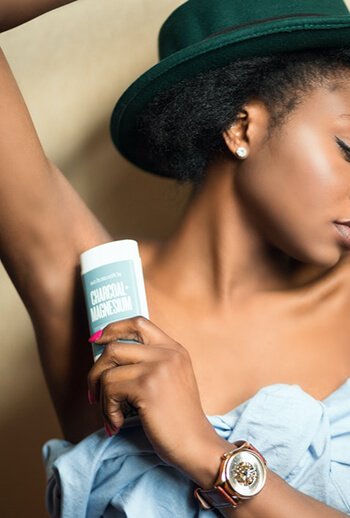
Baking soda can be used as a natural deodorant for the underarms, feet, and anywhere else that takes on an odour thanks to its ability to deodorize by bringing both acidic and basic odour molecules into a neutral, more odour-free state. Combine equal parts baking soda, tea tree oil, and corn starch. Mix the formula well and keep it in an airtight container. Then dab the homemade deodorant onto your skin using a brush or a pad.
2. Remove dirt and grime from hard floors
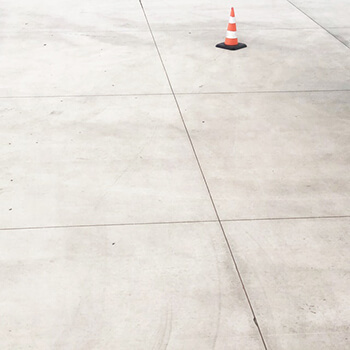
Hardwood flooring that's stained with spills and other marks is difficult to treat, but baking soda is likely to tackle it effectively. Apply baking soda to stains such as mildew, soap scum, or hard-water deposits, then use a little muscle to scrub the stains away.
The great thing about baking soda for your flooring is that it’s tough enough to do the job, but it won’t leave scratch marks. Just add half a cup of baking soda to a bucket of warm water. Then mop and rinse for a sparkling floor.
3. Fix musty books

The same baking soda that absorbs bad odours in the air can absorb the bad odours in your books. Place a cup of baking soda or an opened box in a plastic box or bin with a lid. Put the book in the box with the baking soda and close the lid.
Leave it for up to three days, then check on the book. For bigger problem books, sprinkle baking soda directly onto the pages and follow the same waiting process to give them time to air out.
4. Make toothpaste
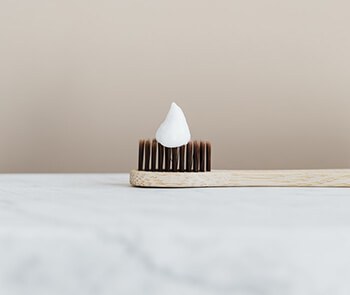
Baking soda has natural whitening properties, which is why it's a popular ingredient in commercial toothpaste. It's a mild abrasive that can help scrub away surface stains on teeth, and it also creates an alkaline environment in your mouth, which prevents bacteria from growing.
To make baking soda toothpaste, mix baking soda with a 3 percent hydrogen peroxide solution. Use the resulting paste as an alternative to commercial non-fluoride products. To make a more appealing peppermint toothpaste, simply add peppermint essential oil for flavour.
5. Handwash dishes, pots, and pans
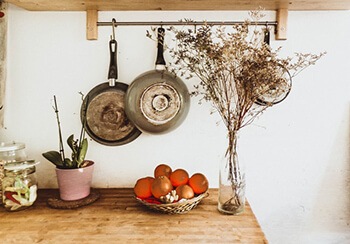
If you’re struggling with greasy pots and pans, try adding 2 tablespoons of baking soda to your regular dish detergent to your washing up water to help cut grease and foods left on their surfaces.
If you’ve got a particularly difficult-to-scrub stain, sprinkle the pot or pan with about a tablespoon of baking soda, then add a cup of water and half a cup of vinegar and boil the mix on the stove for 10 minutes. The food or stain should wipe away easily once cooled.
6. Unclog drains
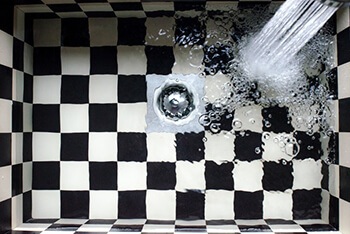
Baking soda is sodium bicarbonate, a base. Vinegar is made up of water and acetic acid, which is an acid.
When you combine these two ingredients, a reaction happens where molecules get exchanged, creating carbon dioxide and water that bubbles through clogs in your drain, breaking it up to create loose material. As drainage pipes aren’t pressurized, when you use boiling water to flush the drain, pressure is added.
This pressure helps in the process of removing unwanted goop out of the pipes and unclogs drains. Just toss 1 cup of baking soda down the drain, then pour a cup of white vinegar. Let it sit for half an hour before pouring in hot water on top.
7. Deodorize drains
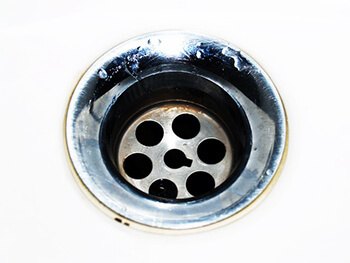
No matter how clean you might keep your kitchen and bathroom, there’s very little you can do to keep the inside of your drains pristine and sparkling. For this reason, they may start to emit bad smells from time to time, and your best solution for this is to not fight one smell with another, but eliminate the smell entirely with baking soda.
Just pour half a cup of baking soda down the drain while running warm tap water. This will deodorize your sink and tub drains, and keep lingering acid and basic odours from resurfacing for at least six weeks.
8. Clean the microwave
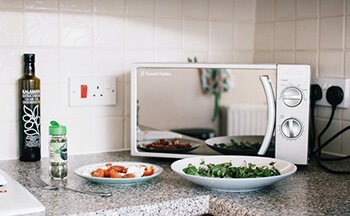
Microwaves have a tendency to accumulate residue from various foods. If they’re not immediately cleaned, further cooking can make these spills set, making them even more difficult to remove. While wiping these stains down will definitely help, it’s also possible to microwave a solution of water and baking soda to make the residue easier to clean, as well as dealing with any unpleasant odours.
You have two options here: the first is to sprinkle baking soda onto a moist sponge and clean gently inside and outside the microwave, before rinsing well with water.
Alternatively, add a couple of teaspoons of baking soda to a bowl of water and place it in the microwave. Heat the solution for 3 to 5 minutes, then when the microwave stops, keep the door closed to give the moisture and steam from the bowl plenty of time to work. Finally, remove the bowl and wipe the inside of the microwave with a damp cloth.
9. Clean coffee/teapots and mugs
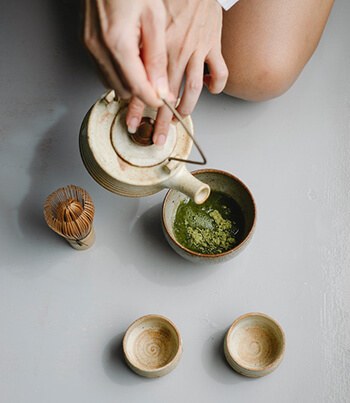
If you’ve started to notice a brown residue on your coffee mugs and carafes, try adding an occasional baking soda scrub to your cleaning rotation. You can remove these stubborn coffee and tea stains by washing your mugs and coffee makers in a solution of one-quarter cup baking soda in 1 quart of warm water containing a squeeze of lemon juice and the peel from a quarter or a lemon.
If the stains are stubborn, soak overnight in hot water and baking soda, then wash them well in the morning.
10. Remove oil and grease stains
Oil stains can be unsightly, whether they’re on fabric or concrete. Not only that, they can be difficult to remove, especially if they’ve been sitting for too long.
11. Treat wood stains
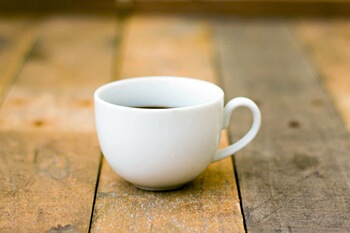
It’s sure to happen. Someone sets a glass on a wooden tabletop. Before you can slip a coaster underneath it, a ring appears on the wood. Before you spend a fortune on refinishing costs, try baking soda instead. Create a simple paste made of baking soda mixed with a few drops of water. Using a clean cloth, rub the solution into the stain, and wipe it off.
12. Remove blood stains from fabrics
You can get difficult stains like blood and chocolate out of clothing and fabric without using toxic chemicals. If the stain is fresh, the blemish might be removed by washing in cold water, so act quickly if you can.
If the stain is proving particularly stubborn and hard to shift, try steeping the fabric for some time in cold water containing a pinch of baking soda. You can also apply a baking soda paste, made from 3 tablespoons of baking soda and a third of a cup of water to bad stains and let it sit for three hours before washing
13. Freshen up your mattress
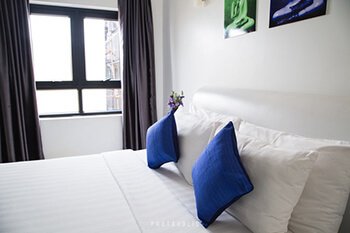
We routinely remember to strip our beds and remake them to make sure the sheets are nice and fresh when we climb into bed at night. But how often do we think about our mattress?
14. Clean and refresh your thermos
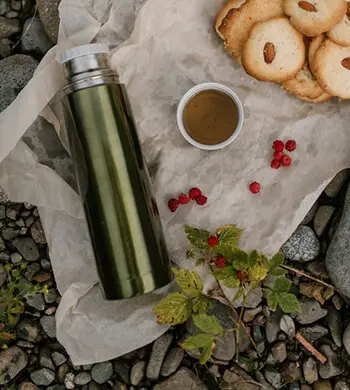
Cleaning a thermos bottle can be hard work, especially if the neck of the bottle is too small to be able to reach inside to scrub the bottle out with a sponge. It’s very easy to forget about cleaning your bottle entirely, which is bad news for your immune system, which may have to fight bacteria and other microorganisms that make a home in the damp spots of your bottle after lengthy periods of use.
Luckily, it’s easy enough to clean out your bottle with baking soda. Just put a large teaspoon of baking soda straight into the bottle, add boiling water, and seal for a few hours. As a result, all the adhering material loosens and comes off easily. Rinse well and leave to dry before using again.
15. Clean walls and furniture
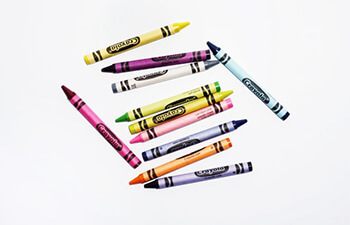
Cleaning painted walls and furniture may seem like a daunting task, but it’s actually quite simple, albeit somewhat time-consuming. The first thing to know is that whether you’re doing yearly cleaning or hoping to say goodbye to a stain, the right approach depends on what type of issue you’re dealing with.
16. Clean shower curtains
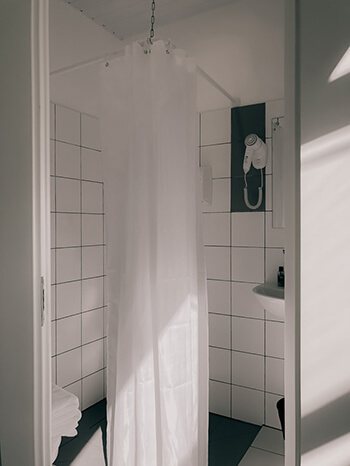
The cleaner you get in the shower, the dirtier your shower curtain and liner can become. Not only does dust and soap scum accumulate on the curtain and liner over time, but the heat and moisture produce conditions that allow mould and mildew to thrive.
To remove stubborn stains, sprinkle baking soda on a damp, microfiber cloth and use it to scrub the entire shower curtain. Rinse with a clean, damp cloth until all the baking soda is removed. If the curtain has more stubborn stains, scrub them again with baking soda until the stains are gone, then rinse again.
17. Clean the oven
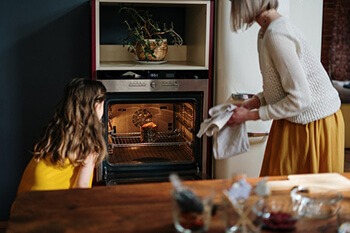
There are a variety of methods to clean an oven, but many of those methods involve the use of chemicals. Using baking soda is a great, natural alternative to harsh chemicals.
First, take out your oven racks and check to see there’s nothing left inside the oven before getting started. Then sprinkle a formula of baking soda mixed with salt onto the bottom of the dirty oven. Spray the area with water to dampen the mixture.
The paste works best if you allow it to sit overnight or for 12 hours. If you don’t have that much time, you can let the paste sit for 40 minutes. When the time is up, scrub the oven and scoop out the baking soda and grime out with a sponge, before following with a rinse clean.
18. Clean your stovetop
Regular cooking inevitably means a messy cooktop. Whether it’s gas, electric, or even glass, it takes more than a half-hearted promise to really clean it one day.
If you’re looking for a powerful clean without the powerful chemicals, you know what to do. Liberally sprinkle baking soda around the top of the stove then spray the area with hot water– enough to dissolve the soda without spilling around. Let it soak for about half an hour, then use a cloth or a sponge to scrub clean.
19. Deodorize and clean your dishwasher
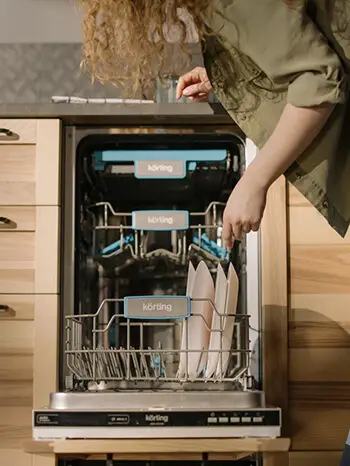
When you use your dishwasher on a daily basis, tiny bits of food, grease, and dishwasher soap scum can cling together and form deposits in all the nooks and crannies of the appliance. After a time, they can not only make your dishwasher look and smell bad but decrease its efficiency as well.
20. Tackle slippery footpaths
Although commercial de-icers can melt ice on footpaths and roads, they can cause damage to the concrete. Here’s where baking soda comes into use – its function is a lot like salt because it contains sodium, which helps to lower the freezing temperature of ice and cause a melting effect.
If you happen to have a good stock of baking soda to hand on an icy day, sprinkle a generous amount of the stuff onto your icy patches on walkways. This is a very simple and effective way to eliminate slipping hazards without salt.
21. Handle marble and granite stains
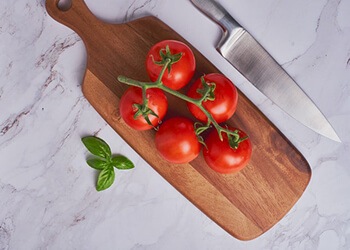
Marble and granite countertops are gorgeous, but they’re porous and will soak in liquids that can leave stains – even sitting water. Many types of liquids and sauces can leave their mark, including fruit juices, wine, coffee, tea, water, vinegar, vegetable and olive oils, sauces, grease splatters, and so on.
The best way to keep marble or granite countertops stain-free is to spray the stain first with water, then cover it completely with a thick paste made from baking soda and water. Place a plastic bag or wrap on top of the area and allow it to sit for at least 24 hours. After 24 hours, remove the solution and wash the area with mild soap and water.
22. Refresh a vacuum bag
It's a given that your vacuum cleaner should help your home smell better, not worse -- but if the appliance itself begins to smell bad, it will release its foul odour all over your home every time you use it. Odours in vacuums can have several causes, from mouldy coffee grinds in the bag to pet hair clogging the works.
You can prevent the machine from smelling bad by making your own vacuum bag sachets filled with backing soda and dried herbs. Slip these fragrant sachets into your vacuum bag and enjoy the pleasant fragrance when you vacuum the floor.
23. Extinguish minor grease fires

A grease fire happens when your cooking oil becomes too hot. When heating, oils first start to boil, then they’ll start smoking, and then they’ll catch on fire.
Luckily, minor grease fires can be controlled and put out without causing major damage to your kitchen. Instead of panicking if you ever find yourself fighting a grease fire, go for your baking soda stash as soon as you can.
When baking soda is heated, it gives off carbon dioxide, which helps to smother the flames. Turn off the gas or electricity if you can safely do so. Stand back and throw handfuls of baking soda at the base of the flame.
24. Keep brushes and combs clean
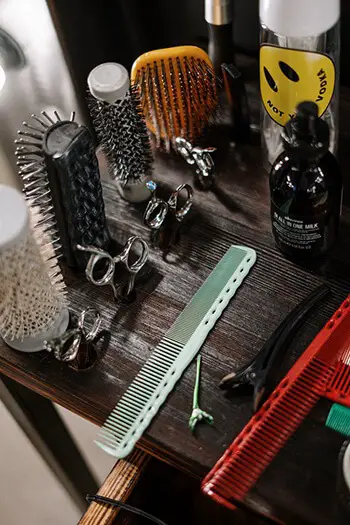
Cleaning your hairbrush or comb is a task that often gets neglected or is never done at all. But it’s important to protect yourself against bacteria and allergens like mites that you could get from your brushes, so you should plan on cleaning your brush at least once a month if not once a week.
To clean your brush the natural way, first, remove any hair from the bristles using a comb to go through the brush. Then submerge the brush in a solution of baking soda and water until the teeth or bristles are covered.
Soak for at least 30 to 60 minutes, then rinse well in hot water. The gunk should be gone.
25. Improve hair health

Using a baking soda and vinegar-based hair regimen is rumoured to help reset your scalp to its natural pH, which could be made more acidic or more basic depending on the products you use. For this reason, resetting your hair and scalp's pH balance back to its normal baseline can help remedy a number of issues, including dandruff, scalp irritation, dryness, and more.
Sprinkle a generous amount of baking soda into your palm along with your favourite hair care product. Apply to your hair and scalp, leave for up to half an hour, then shampoo as usual and rinse thoroughly.
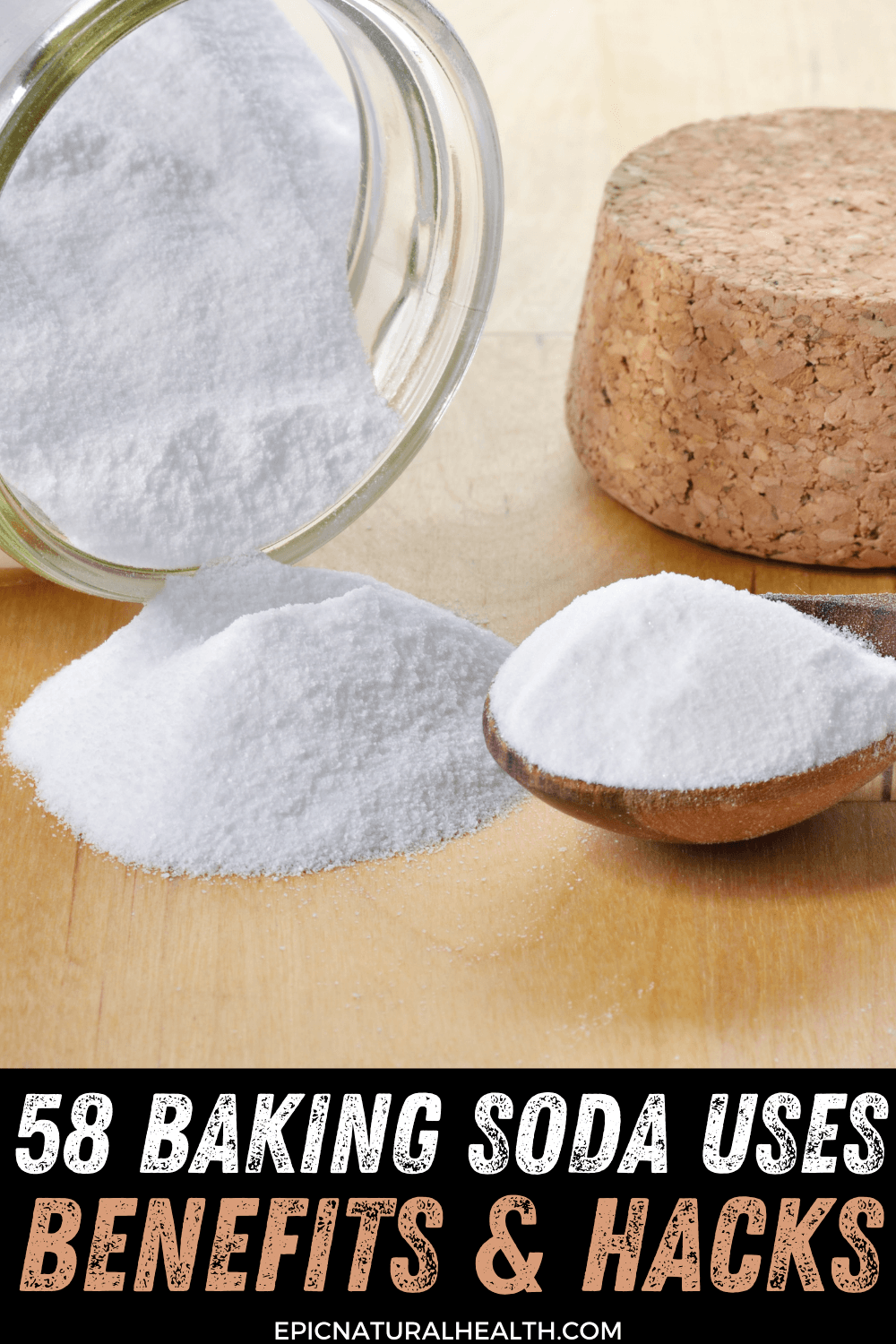
26. Revive sponges
Sponges, by their very nature, get gross pretty quickly. If you find yourself throwing them out more often than you'd like, there's an easy way to at least make them smell a little fresher. All you have to do is soak the offensive sponges in a solution of four tablespoons of baking soda, and one quart of water. After a few minutes, they should smell about as good as sponges can smell.
Note that you can’t ever bring an old sponge back to like-new quality, so you should still replace your sponges fairly frequently.
27. Polish silverware
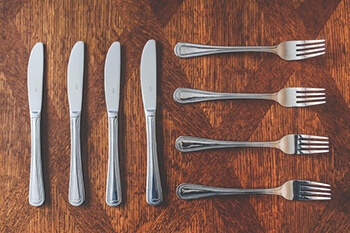
There's nothing more disheartening than spending a fortune on silver items and watching them tarnish before your very eyes. Unfortunately, silver tarnishes when it’s exposed to air. It's part of a chemical reaction that affects a variety of silver pieces, from jewellery to flatware.
Cleaning silver with baking soda is one of the most environmentally friendly ways to remove stains from the precious metal. Make a baking soda paste made with 3 parts baking soda to 1 part water, and rub it onto the silver with a clean cloth or sponge. Rinse thoroughly and dry for a shining set.
28. Give your laundry a boost
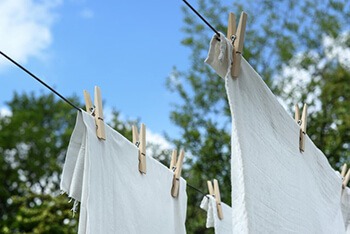
With so many different fabrics, messes, and odours to get clean, a hamper full of dirty laundry can give your detergent a good workout. No matter which detergent you choose, you can boost its cleaning and deodorizing power by adding baking soda.
This is because, when paired with your laundry detergent, baking soda uses the power of pure sodium bicarbonate to neutralize odours by balancing pH levels, helping to soften wash water, so you can use less detergent or bleach while enjoying cleaner clothes. Just toss half a cup of baking soda into your laundry to make your liquid detergent work harder.
29. Fix deodorant stains
Some deodorant stains are more troublesome than others. The yellow stains in the armpits of your tops come from a mixture of the salt in your sweat with the aluminium in your deodorant.
Aluminium is commonly used in antiperspirant deodorant because it clogs up pores, preventing sweat from generating. You can prevent unsightly deodorant stains on your clothes by applying baking soda to your underarms after applying deodorant.
30. Make a brass cleaner
As brass ages, it takes on a darker colouring, or tarnish. Tarnishing occurs when air reacts with the metal, leading to the deepening of copper's colour.
Removing tarnish and bringing out the shine in brass items is safely accomplished by cleaning them with a wedge of lemon sprinkled with baking soda. This method will provide a gentle abrasive solution for cleaning and shining.
You can also mix half a cup of baking soda with a cup of white vinegar, then dip a clean cloth into the mixture and use it to apply the paste to the brass item. Leave for 10 minutes before rinsing off and wiping clean.
31. Shine tile grout
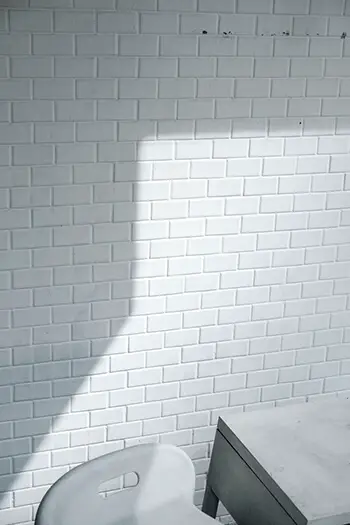
Without cleaning, your grout changes from a clear white to an unappealing brown. With baking soda, you can effectively remove dirt and mould stains, while cleaning and brightening your tiles, without having to hire a professional.
Combine 3 cups of baking soda with 1 cup of water, then apply the solution to your grout with a brush or a sponge. Leave for several minutes, then rinse the area clean.
For extra benefit, try adding vinegar and warm water mix to the area before removing the baking soda, which will cause the baking soda to fizz. Leave to rest for 5 minutes before scrubbing the grout and washing it clean.
32. Freshen up dish racks
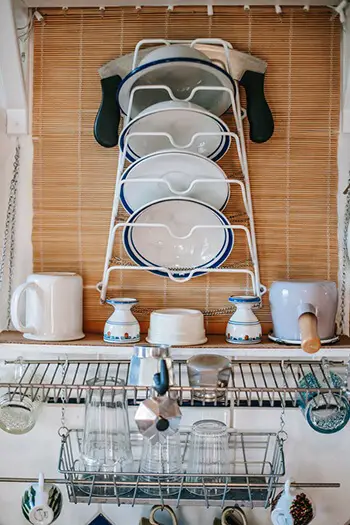
You wouldn’t think a dish rack would get all that dirty just holding freshly washed dishes, but it can. Hard water stains, mineral deposits, and mould are all unsightly, odour causing possibilities.
It’s simpler than it seems to revive your dish racks – you just need to commit to regularly scrubbing them with a paste of baking soda and water. Use a toothbrush to get tight spaces and hard-to-reach corners. After the rack has been thoroughly cleaned, use a clean cloth to dry or set it in an out-of-the-way place to air dry.
33. Make cheap and natural carpet & rug freshener
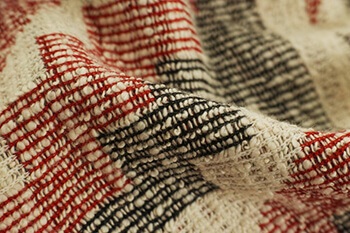
A baking soda carpet cleaner can help to freshen and revitalize your carpets. More importantly, it’s an inexpensive solution that will have no lasting impact on the environment and, it will do the job of helping to get rid of odours and stains with ease.
Sprinkle your carpets with a good coating of baking soda and leave it to sit for a few hours before sweeping vacuuming up the rest. Your carpets will smell noticeably fresher.
To remove stains, add some hot water to your baking soda and let the stain sit for at least 3 hours. Repeat if the stain is particularly embedded into your carpet.
34. Revitalize wardrobes
Baking soda is often used to remove clothing stains, but we know, it’s also an excellent odour absorbent. Add 2 to 3 tablespoons of baking powder to a breathable container or box and place it inside your wardrobe.
Baking soda also absorbs moisture, freeing your clothes of the mildew-like smell.
35. Deodorize bins
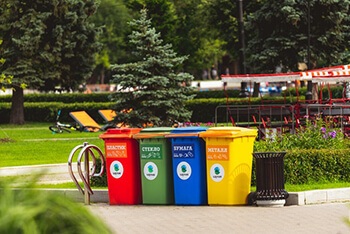
Bin odours can leave a lingering unpleasant smell in the air, so it’s important that you your trash receives routine cleaning. Even if you take out the rubbish every night, bits of gunk, garbage, and stains can easily build up in your bin, causing it to develop a less-than-pleasant smell.
A thorough cleaning will get rid of this build-up and prevent foul smells in your kitchen. The simplest way to deodorize your bin, and keep lingering odours at bay, is to sprinkle baking soda on its bottom. Baking soda will neutralize, not just cover, bad smells, and prevent them from resurfacing.
36. Remove odour from a vase

Vases, especially slender vases or tall and tapered vases, are quite a challenge to clean since you can’t reach inside with a cloth or your hand. The best way to clean vases without actually scrubbing is to fill the vase with a solution of water and baking soda and let the solution sit for a few hours.
Wash the vase clean, and you should find that any unpleasant stains and odours are gone. If the first time hasn’t done the job, simply repeat the process.
37. Make a dog deodorizer

Dogs can’t help having their natural scent, and it’s often the case that no matter how many times you give your four-legged friend a bath, he’ll always end up smelling again by the next morning. If you’re inviting guests around or you just want your home to smell fresh in the short-term, try mixing half a cup of baking soda with 2 cups of water.
Then soak 1 neckerchief, appropriately sized to fit a dog. Wait for the neckerchief to naturally dry, then tie it around your dog’s neck to help keep the odours away. This shouldn’t be uncomfortable for your pet, but some dogs are more relaxed than others, so if your dog doesn’t like it, this hack probably isn’t for you.
38. Clean your freezer
Because the freezer is a place for long-term storage, it’s easy to forget what we’ve put inside — and it’s also easy to let sneaky leaks go un-wiped and for food debris to gather in its nooks and crannies. Again, in this case, baking soda is your cleaning best friend.
After thorough washing with soapy water, give your freezer a quick rinse with a solution of baking soda and warm water. It will help to remove the soap residue as well as freshen things up. Leave for 5 minutes, then wipe off the inside with a clean cloth.
39. Clean lunch boxes
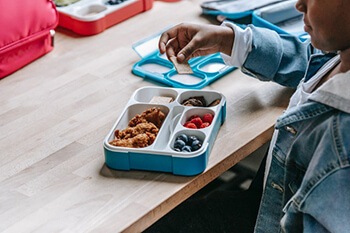
The best way to avoid a smelly lunch box or bag altogether is to make a habit to remove everything from it right away, then use a slightly damp towel with a small amount of mild dishwashing detergent to wipe the inside and outside. If you’ve left things a little too late, though, you can still freshen out your lunch bag with baking soda.
Just sprinkle the stuff inside the lunch bag and fill it with crumpled newspaper to absorb the moisture and smell. Close the bag and after 1 or 2 days, remove and discard the newspaper and baking soda. Wipe the inside of the lunch bag with a clean, damp towel and allow to air dry.
40. Freshen bedding
When it comes to treating your bed to a new set of fresh linen, everyone wants to experience that clean scent. Too often, however, getting that clean scent takes a whole lot of unwanted chemicals.
If you’re looking for a chemical-free remedy, try combining dried, ground herbs with half a cup of baking soda to freshen your bed linen. Apply the baking soda straight onto the bedding, then leave it for several hours before vacuuming the baking soda away.
A simpler solution is to store your baking soda and herbs in an open-lid box in your laundry cupboard.
41. Fix Hard Water Laundry
In regions where the water supply has a high mineral content, baking soda added to a load of laundry will prevent the dinginess in clothes washed in hard water. Try adding a quarter of a box of baking soda to the wash as a laundry booster.
42. Make toilet cleaner and freshener
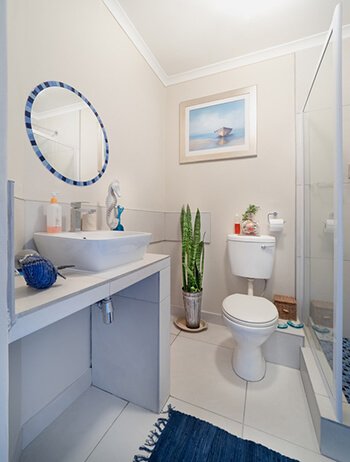
The toilet is an area of the home that requires regular cleaning, as nasty residue can quickly accumulate on the toilet surface, leaving unattractive discoloured stains. There is a whole range of retail toilet cleaning products on the market, but these contain harsh chemicals that are better off avoiding altogether.
Try using baking soda instead for a similar cleaning effect. First, tip out 1 cup of baking soda into the toilet, then follow it up with 1 cup of vinegar. Let the solution fizz for 20 minutes, then get a toilet brush to scrub the toilet bowl clean. Flush and step back to examine your impressive handiwork.
43. Clean battery connections
Cleaning your battery connections, especially if the terminals are corroded, will help ensure the battery lasts longer and performs well. Corrosion shows up in the form of a crusty, fuzzy-looking substance that leaves a mess on your car battery terminals and cable ends.
Baking soda can be used to neutralize battery acid corrosion on cars, mowers, and so on. Make sure to disconnect the battery before cleaning the battery connections. Make a paste of 3 parts baking soda to 1 part water, then apply with a damp cloth to scrub corrosion.
44. Clean your car

You can use baking soda to clean nearly every area of your car. Get started by making a baking soda solution of a quarter-cup baking soda in 1 quart of warm water. Apply the formula to clean your car lights, windows, chrome bumpers and trim, and floor mats.
You can also use baking soda on your upholstery and car seating. For stubborn stains, use baking soda directly from the box on a damp sponge. For fabric upholstery, sprinkle baking soda on spots and stains while the spill is fresh and brush it off after all the moisture is absorbed.
45. Treat cold sores
You can spend a lot of money on expensive cold sore remedies, but this DIY baking soda version will cost you mere pennies. Mix a small amount of baking soda with enough water to make a paste, and apply the paste to the cold sore.
Allow it to dry, then rinse and pat dry. Repeat every day until the cold sore disappears, usually in about a week.
46. Fix smelly ashtrays
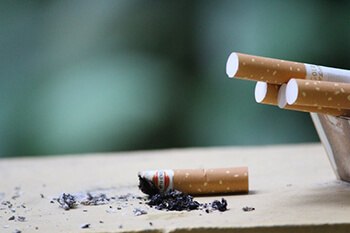
If you find cleaning ashtrays a real headache, you’re not alone. The ashes stick to the surface of the ashtray and refuse to come off, leaving a lingering smell of stale smoke in the area.
Though you might not be able to fully de-stain your ashtray, you can get rid of the odour with baking soda. Just mix equal parts white sand and baking soda and pour the mixture into your affected ashtrays.
This helps diffuse the odour from cigarette butts when you place them in your ashtray and also helps neutralize the smoke in the air.
47. Make luggage freshener

Suitcases are only used on occasion, and between uses, the bags can sometimes accumulate a stale, unpleasant smell. To keep the luggage smelling fresh, you want to deodorize in a way that uses no chemical cleaners that could absorb into bag or future items that you place in the suitcase.
Smelly luggage cases can be freshened up by sprinkling baking soda inside, closing the piece, and then letting it sit for a few days before vacuuming out.
48. Natural nausea remedy
If you’re dealing with nausea from travel sickness or acid reflux, you may not have to reach for over the counter anti-sickness medication. An effective drink for nausea can be made by dissolving 1/2 teaspoon of baking soda in 4 ounces of water.
Baking soda is thought to help with nausea by changing the pH of the acids in the stomach. Just be sure to check with your doctor to make sure that this remedy won't interfere with any medications you’re taking, and don’t try it if you’re pregnant or on a low-sodium diet.
49. Ease Toothache

If you’ve ever had a toothache, you know that it can be one of the most painful situations you want to avoid. It can happen to anyone without warning.
A simple way to soothe toothache pain is to moisten a cotton swab and coat it well in baking soda. Use the cotton swab to rub the baking soda into your affected tooth and gums until the pain dies down.
This is, of course, a short-term remedy – you should always visit a dentist if you have recurring tooth pain.
50. Use as an antacid
Baking soda is a good treatment for immediate relief from occasional acid reflux, as well as digestion and stomach issues. The recommended dosage for adults is half a teaspoon dissolved in a 4-ounce glass of water.
It's best to sip this drink slowly to avoid side effects like gas and diarrhea. You can repeat every two hours until your condition improves.
51. Relieve a sore throat
Having a sore throat is an unpleasant experience, but when it comes to treatment options, the key to soothing it can be closer than you think, often in your kitchen cupboards at home. Baking soda has antibacterial properties, which can help to kill off the nasties camping out in your throat.
It also has a slightly alkaline pH, which soothes minor skin irritations such as bug bites and rashes – and will have a similar effect on the swollen tissues in your throat. Make your own baking soda sore throat remedy by mixing half a teaspoon of baking soda and salt together with half a cup of warm water and gargle several times a day.
52. Cleanse your face
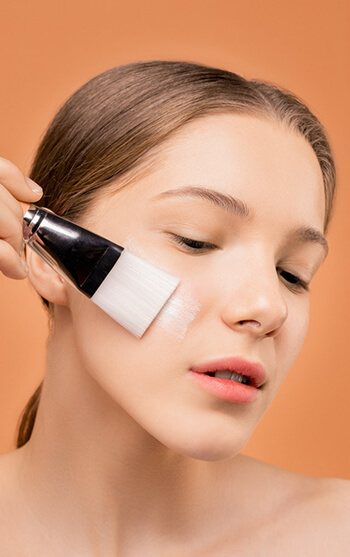
There's nothing like the satisfying smoothness of freshly exfoliated skin. However, many commercial exfoliants rely on environmentally damaging plastic microbeads to give you that just-scrubbed feeling.
Make your own bead-less exfoliant by combining baking soda and water to form a gritty paste. Use gentle circular motions to rub the mixture across your face and rinse with cool water. It's important to test it on your arm first to ensure you don't have a negative reaction.
53. Buff your nails
If your nails are looking a bit worse for wear, this simple baking soda remedy is for you. Combine three parts baking soda and one part water to create a gentle yet effective scrub to buff and exfoliate nails.
Rub the formula gently in circular motions over hands and fingers to seriously smooth the nail surface, then wash and pat dry with a towel.
54. Treat athlete’s foot
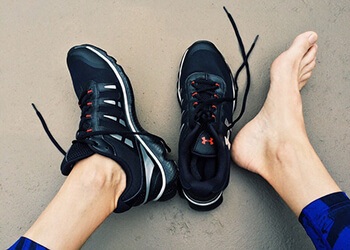
Baking soda has antifungal properties and can help inhibit fungal growth in a variety of human skin and nail infections. Try applying a baking soda paste to your athlete’s foot to treat the fungal infection on your feet or between your toes.
Just add one tablespoon of baking soda to a bit of lukewarm water, then rub the resulting paste on your infection before rinsing and drying your feet thoroughly. Don't forget to apply baby powder after to keep your feet free of moisture.
55. Remove fake tan
A mix of baking soda and coconut oil is an easy, gentle way to exfoliate away your leftover self-tanner or spray tan. You can also use this trick to remove any tanner mistakes caused by drips or letting the product sit on your hands for too long.
If you don’t have coconut oil to hand, try mixing two tablespoons of baking soda with some water and rubbing the paste over your fake tan for a similar effect.
56. Remove hair
You can remove hair naturally and without all the pain of waxing with this natural baking soda solution. Mix together 2 parts baking soda with 1 part turmeric and then add a few teaspoons of water to form a paste.
Spread the mix on the patch of unwanted hair and leave it to dry. Then remove the dry paste by rubbing it off with your hands or a dry towel. Shower to remove any residue and colour left by the turmeric.
57. Get rid of under-eye dark circles

Baking soda has brightening properties that can help you to get rid of dark circles. To try this remedy for yourself, just mix 3 parts baking soda to 1 part water until a paste is formed.
Apply the paste to the undereye area using the back of a spoon and leave on for 5-10 minutes. Carefully rinse it off, being careful not to rub it into your eyes.
58. Flush out earwax
If excess wax is making it difficult to hear, use a simple baking soda solution to flush out the wax. Use a 15% baking soda solution, made by adding a quarter of a teaspoon of baking soda to 2 teaspoons of water.
Fill the ear canal and leave it in for 1 hour to soften the wax. After an hour, most the earwax should be dissolved. You can then wash the wax out with water at body temperature, adding a little hydrogen peroxide in a syringe if needed.
Conclusion
And that wraps up our biggest compilation of baking soda uses to this date – but if we have missed anything out, be sure to let us know! It seems there really is no end to the wonderous uses of baking soda.


